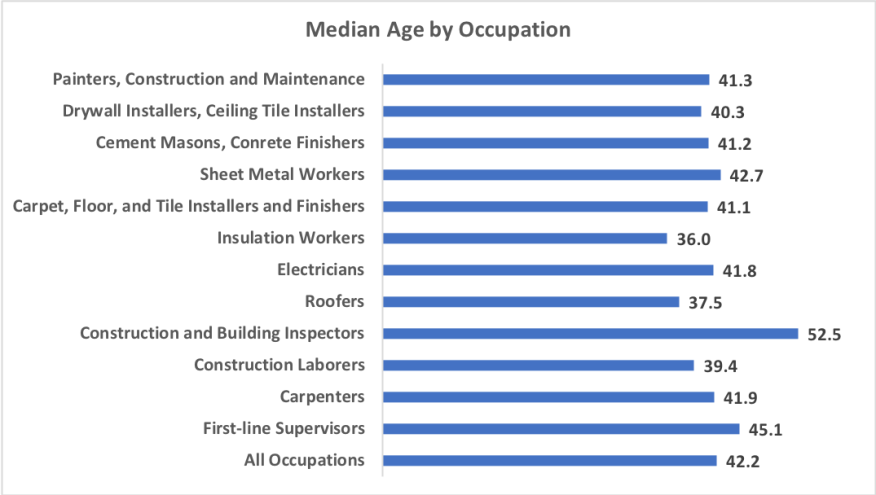This story was originally published in Builder.

The rising age of building pros across the U.S. has implications for impacting an already-tight labor market. Several builder-related professions have median ages far above the national median for all occupations, and most builder-related occupations employ a higher percentage of workers age 45 to 54 than 25 to 34, according to the Bureau of Labor Statistics (BLS).
Robert Dietz, NAHB chief economist, says the share of NAHB members over the age of 55 has increased to 57% from 38% in the past 10 years, with the average age of members at 57, according to the association’s most recent data. One possible explanation for the older workforce, Dietz says, is the smaller amount of Gen Xers in the workforce relative to baby boomers.
Another factor contributing to the lack of young workers in the industry is the emphasis on higher education, says Brian Turmail, vice president of public affairs and strategic initiatives for Arlington, Va.–based Associated General Contractors of America. “Few schools offer career and technical education programs focused on construction, and for much of the past 30 years society has signaled to students and their families that the only path to success lies through college and an office job,” he says.
The aging workforce may soon compound U.S. builders’ labor issues—a top concern for NAHB members. With 240,000 unfilled construction jobs in the U.S., an aging workforce may create other problems for builders. Turmail says there are also health and safety issues related to employing a smaller, older workforce as the fatigue and stress on older bodies could exacerbate firms’ inability to keep pace with demand.
“If more young workers do not enter the field, many firms will be forced to adopt labor-saving technologies like robotics and autonomous equipment and labor-saving techniques such as lean construction and off-site prefabrication,” Turmail says.
By the Numbers

The median age for builder-related occupations is 41.7 years old, according to the BLS—half a year younger than the median age for all occupations—but there is a higher percentage of workers over the age of 55 in builder-related professions than in all occupations. In builder-related professions, 17% of workers are age 55 to 64, and 6% of employees are over age 65. These distributions are higher than the national distributions of workers in all occupations, where 15% of employees are between the age of 55 and 64, and 3% of employees are over age 65.
Building firms also have fewer workers age 25 to 34 than the national distribution for all occupations. And the numbers are even fewer for the youngest set of American workers. The Wall Street Journal recently reported the share of workers 24 years old or younger in the construction industry has declined nearly 30% nationally since 2005. The share of workers in the sector who are 24 years old or younger has declined in 48 states in that same time period.
Some of this reflects a larger trend: Dietz says the number of workers over age 55 in the overall economy has increased by 17 million since 2000, while the number of workers under age 55 has increased by only 1 million.
Older Workers
A closer look at the data shows that several builder-specific fields have a higher median age than the national median. The median age of construction and building inspectors is 52.5 years old, and the median age of first-line supervisors is 45.1 years old. The BLS estimates there are 59,000 more first-line supervisors between the ages of 45 to 54 than 25 to 34.
Dietz says welders, skilled electricians, and masons are professions recent NAHB surveys suggest are getting older relative to other builder-related careers. However, he adds, just because these areas have a higher median age does not mean they are where the labor shortage is most pronounced. Framing and carpentry, despite polling lower median ages in NAHB surveys, are two areas where the labor shortage is greatest.
Dietz and Turmail both say more effort is needed for the industry to attract young workers. Local builder associations, community colleges, and construction-focused school programs can play a role in engaging the next generation. Dietz says many business owners and senior staffers in the industry got their starts in the construction trades, suggesting the trades are an important area for recruitment efforts.
This story was originally published in Builder.















